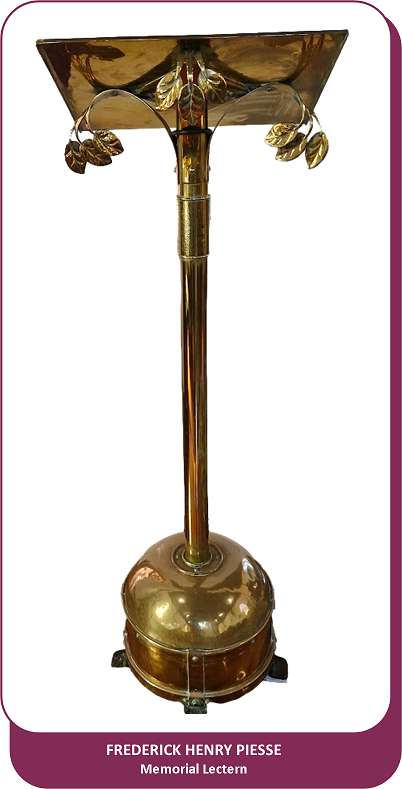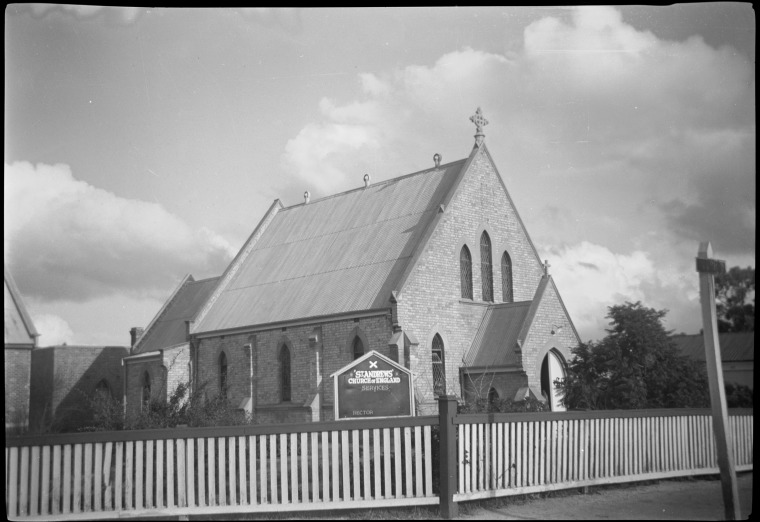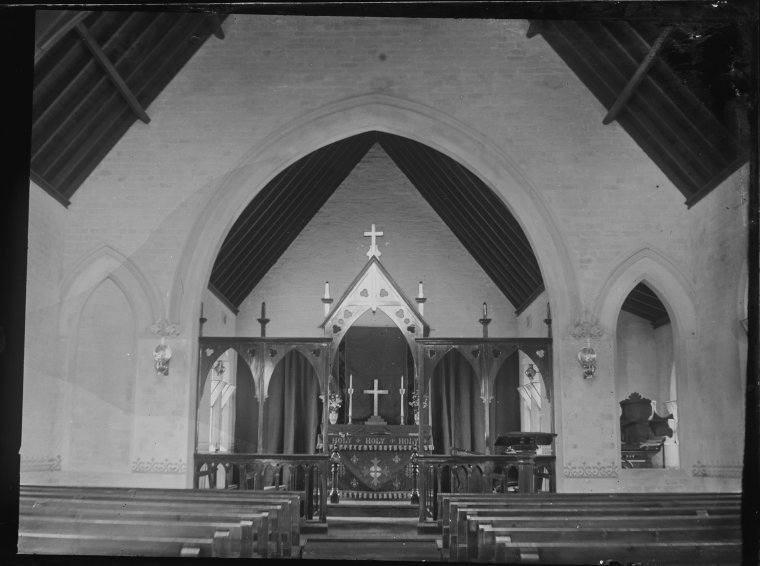Anglican Church. Anglican Church. Anglican Church.
Anglican Church – Saint Andrew’s
In May 1896, Bishop Riley wrote to Mr. Arnold Piesse beseeching him to investigate the building of a church, because the population of Katanning had outgrown the usual meeting places of private homes, the hotel and F. & C. Piesse’s hall.
St Andrew’s Church c1920
In 1897 an application to sell Lot 51 was approved and the proceeds of the sale to be applied to the building of the church. In 1898 an application for a loan in aid of a church building was approved.
The Bishop was also anxious to have a rectory built with the least possible delay on the church site. With typical pioneering spirit the challenge was taken up and, on June 25, 1898, the foundation stone of the new church was laid by Mrs. F. H. Piesse, on Katanning block 428 on the corner of Aberdeen and Arbour Streets, about one kilometre from the railway station.
The architect was Mr. P. W. Harrison and the contractor was Mr. A. J. Stewart. The building is constructed of local bricks on a foundation of plinth concrete with forty thousand of the bricks a gift from Messrs F. & C. Piesse. The roof and floor are made of Jarrah, a gift from the Millar brothers, and the porch is laid with Milton tiles. The Chancel window was erected in 1910 and this window, together with the brass plaque by the organ loft was erected in memory of the Piesse family.
Mr. Frederick Henry Piesse presented a large King James Bible to the church. The inscription reads, “A.M.D.G …. Presented for use in St Andrew’s Church Katanning by Fredrick Henry Piesse, Christmas 1910”.
St Andrew’s Church c1930
After the death of Mr F. H. Piesse, the parishioners commissioned G. Holdsworth of Bridgetown to fashion a brass lectern to honour his memory. The inscription reads: “To the Glory of God and in memory of the Hon. Frederick Piesse CMG, Founder of Katanning and a zealous and faithful churchman who entered into rest 29th June 2012. This lectern was given by parishioners.” Piesse was a staunch supporter of the Church of England.

Interior of St Andrew’s Church c1920
St Andrews Anglican Church
Arbour Street, Katanning
St Andrew’s Church Hall
Aberdeen Street
(Adjacent to St Andrews Church)
The Church Hall was built in 1911 – the foundation stone was laid by the Hon. F. C. Piesse M.L.C., the architect was Mr. E. Summerhayes FRIBA, and secretary was Mr F. M. Gare. A piano was donated by Mr. Macrae, and the church became the focus of social life in Katanning.
The building is of Federation Tudor brick asymmetrical construction with timber framed corrugated iron roof and twin roof vents. It is a four bay plan with a centrally located entry between asymmetrical elements at the front and the bricks were locally made. The building also features castellated parapet walling and buttressing, the latter possibly being added after the hall was completed.
The roofing structure is quite unique with a combined rafter and tension cable design truncating the steep roof pitch. The original Gothic arched front door has been replaced although windows and other doors all feature Gothic arches. (from inHerit website)
Extensions made to the rear of the church are of a different style. The interior has solid timber roof panelling and painted walls. The hall is primarily significant in terms of its relationship to St Andrew’s Church, which is the oldest remaining church in Katanning. The functions and events, which occurred in the hall, contributed very much to the social and religious life of the people of Katanning, in particular the large Anglican community. The style of the hall is uncommon in Anglican architecture of the period and is commonly found in non-conformist religious architecture.
The hall and church have strong links with the Piesse family, which contributed much to the construction of both buildings. The Hon. F. H. Piesse laid the foundation stone for the church hall on 27th March 1911, on a site adjacent to the existing St Andrew’s Church.
The hall was used weekly for parish meetings, dances, fundraisers and various other activities. A few years after the hall was completed additions were made to the rear which included kitchen and eating facilities and toilet amenities. In the mid 1950s, room was set-aside in the hall for office space for Mr A. C. Stark, from Wells Organisation Pty Ltd. Mr Stark organised many fundraising events and was instrumental to the continued growth and development of the Anglican community during this time
PAST NEWS
THE ANGLICAN BISHOP.
VISIT ALONG THE G.S.R.
Great Southern Herald
2 May, 1903
The Right Rev. Dr Riley, Anglican Bishop of Perth, preached at St. John’s, Albany, on Sunday last, morning and evening. On Monday he visited Denmark timber mills, returned to Albany on Tuesday, and conducted service at Cranbrook on Wednesday.
The Lord Bishop was met at Cranbrook by the Rev J. A. Howes and reached Katanning on Friday night. Dr Riley conducted a service at St. Andrew’s, Katanning last night, a large congregation assembling.
The Lord Bishop will be in Wagin district tomorrow (Sunday, May 3). He will preach at St. Peter’s Church, Arthur River, in the morning at 11 o’clock, and at St. George’s Church, Wagin, in the evening at 7 o’clock.
THE LORD BISHOP.
TOUR ALONG THE G.S.R.
Great Southern Herald
9 May, 1903
AT CRANBROOK
The Lord Bishop of the Diocese, Dr. C. O. L, Riley, arrived on Wednesday evening last at Cranbrook by the mail train from Albany, and was met by the Rev. Jas A. Howes, Rector of Katanning and District. On
Thursday morning at 8.30 he held a confirmation where Mr David Parker received
the “laying on of hands.”
For a small place like Cranbrook townsite quite a number attended the service, and were well repaid by the eloquent though simple discourse of the Bishop, who traced the “laying on of hands” from the time of our Lord’s Apostles up to the present time. The service was most hearty throughout, the worshipers thoroughly appreciating the Bishop’s visit and the kind words uttered by him.
We might here state that the Rector has applied to His Lordship for a Lay Reader’s license for Mr Parker so that the people of Cranbrook may at least have service on Sunday. We hope to hear of Mr Parker’s success in the good work he is about to start, and hope that the Church’s friends in this outlying part of our Rector’s district will rally round their Lay Reader in the absence of the Rector.
AT BROOME HILL
The Bishop, accompanied by the Rector, left Cranbrook by the morning train, the Bishop arriving at Broome Hill was met by Mr A. M. Nicolson, who drove him to Goblup. His Lordship performed the Sacrament of Holy Baptism to the infant daughter of Mr and Mrs Nicolson.
AT KATANNING
On Friday morning the Bishop arrived at Katanning and was the guest of Mr and Mrs F. H. Piesse at “Kobeelya.” In the afternoon, accompanied by the Rector, several visits were made. In the evening His Lordship preached in St. Andrew’s Church.
Considering that only two days’ notice was given of the Bishop’s intention to preach at Katanning, quite a good congregation assembled, over 100 persons being present when the Choristers formed in procession at the west end door and proceeded to their places in the chancel singing a processional hymn appointed for Easter.
Behind the procession came the Bishop with Mr Frank M. Gare, Lay Reader, carrying the Pastoral staff. The service was choral throughout, the Hon. F. H. Piesse taking the lesson. The sermon was preached by the Bishop, the text being taken from the 3rd Epistle of St. Paul to the Colossians, and the first verse – “If ye then be risen with Christ seek those things which are above, where Christ sitteth on the right hand of God.“
The sermon, which was on the doctrine of the Resurrection, was attentively listened to throughout, and greatly appreciated by all present. The collection was given to the Assistant Bishopric Fund. On Saturday morning the Bishop, baptized the infant son of Mr and Mrs R. McIndo, leaving the same day for Wagin.
AT ARTHUR AND WAGIN
A BANQUET.
The
Bishop arrived at Wagin on Saturday afternoon last by the Albany TO Perth
train. In the evening he was entertained at a banquet held at the Hotel
Federal.
Some thirty representative members of the Church of England were present, Mr Richard Gell J.P., acted as chairman. An excellent repast, which reflected great credit on all concerned, received ample justice.
The usual toasts were duly responded to and the Bishop, in an excellent speech, thanked those present for their kindness, alluded to the want of a fence for the church, the want of a rectory, and the absence of complaints of any kind. He referred to the advancement made in the district since his last visit for the consecration of the church. Wagin had gone ahead by leaps and bounds, and he felt sure it had a prosperous era in front of it. It must be a very healthy place, for instance, there was no family doctor.
Songs and recitations from the company made the evening seem like a short one and, at 9.30, his lordship left for the residence of C. A. Piesse.
On Sunday morning he was driven to the Arthur by Mr A. Chester. Mattins (morning prayer) was followed by Holy Communion by a goodly number of communicants where Miss L. Lizars presided at the organ while Miss Spratt accorded her usual hospitality.
Evensong was sung at Wagin at 7pm followed by Holy Communion. The church was prettily decorated by the ladies of the congregation, and many people had taken their seats before the bell rang at 6.30.
As his lordship preached upon the resurrection and spoke words of consolation to many mourners present and also pointed out the fact of the resurrection of our Lord is the keystone of the Christian religion. Each Easter day, each Sunday, each Holy Communion was a witness to Christ’s resurrection. It is the hope the sin-stricken soul for “Men may rise on steppingstones of their dead selves to higher things.” The collection was given to the further reduction of the church debt. Miss Kerr presided at the organ.
On Monday morning His Lordship formed one of a survey party to the north of Wagin and left for Perth by the afternoon train in the company of the Hon. F. H. Piesse of Katanning.
ABOUT PEOPLE
The Daily News
24 September, 1915
A wedding of great interest in the Katanning district was celebrated on the evening of September 15, when Mr. Edward T. Butcher, son of the late Mr. N. Butcher, late of Tasmania, and of ‘Lowlands,’ Katanning, was married to Miss Muriel Laura Badham, only daughter of Mr. and Mrs. F. N. Badham, formerly of York, and now of ‘Currawong,’ Katanning.
The bridal couple and their families have many friends throughout the district, and as a consequence, St. Andrew’s, where the celebration took place, held a very large assemblage. Rev. Canon Burbidge officiated. The bride was given away by her father and attend ed by Miss Horsburgh, Mr. R. Hunt was best man. The bride was charmingly gowned in white silk crepe and wore the orthodox veil and flowers.
Miss Horsburgh wore a pretty frock of apricot silk and white ninon. A reception was held at ‘Currawong,’ at which about forty guests were present, after which Mr. and Mrs. Butcher left to spend a couple of weeks at Albany, the bride’s travelling dress being a smartly tailored coat and skirt of Assam silk, worn with a pretty hat in shades of purple and pale blue.
The bride’s gift from the groom was a gold wristlet watch, and to the bride groom a set of silver mounted hairbrushes. Mr. and Mrs. Butcher received many beautiful gifts from their circle of friends.
ANGLICAN CHURCH OF AUSTRALIA
The Anglican Church of Australia, formerly known as the Church of England in Australia, is a Christian church in Australia and an autonomous church of the Anglican Communion. It is the second largest church in Australia after the Roman Catholic Church. According to the 2016 census, 3.1 million Australians identify as Anglicans. For much of Australian history the church was the largest religious denomination. It remains today one of the largest providers of social welfare services in Australia. Continue reading
How the Church of England & Anglicanism Came to Be
Anglican Christianity, which stems from the Protestant Reformation, is one of the largest Christian traditions in the world. Moreover, its adherents have often exerted tremendous social and cultural influence, particularly in English-speaking countries. Anglicanism has also undergone many internal conflicts as of late, which have made the news. So where did the Anglican church come from, what do Anglicans believe, and how do they live as Christians today? Continue reading
ANGLICANISM
Anglicanism is a Western Christian tradition which has developed from the practices, liturgy, and identity of the Church of England following the English Reformation.
Adherents of Anglicanism are called “Anglicans”, or “Episcopalians” in some countries. The majority of Anglicans are members of national or regional ecclesiastical provinces of the international Anglican Communion, which forms the third-largest Christian communion in the world, after the Roman Catholic Church and the Eastern Orthodox Church. Continue reading







